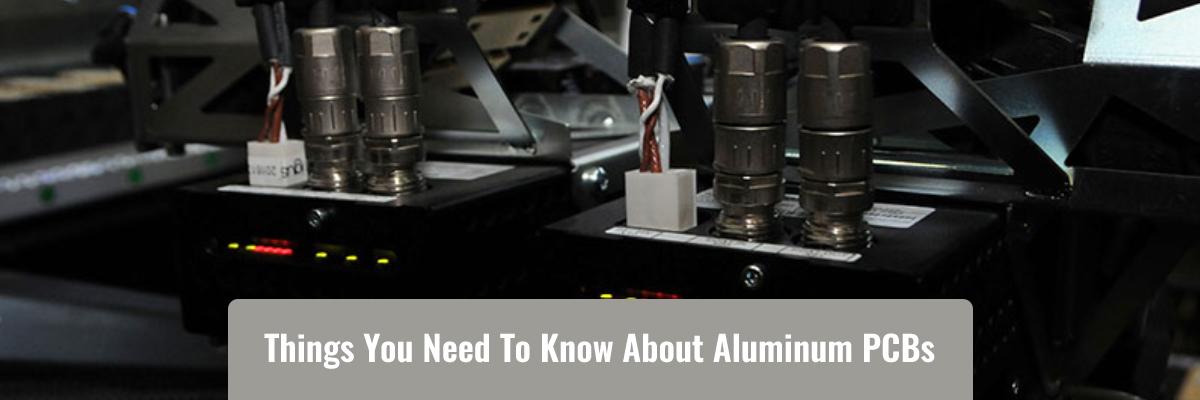Printed circuit boards (PCBs) can be made from various metals. These special PCBs are known as a metal core printed circuit boards (MCPCBS). The choice of metal changes on the basis of an application. Aluminum PCBs are one of the popular types of metal MCPCBS, which find use in many modern day applications. These PCBs feature metal-based and copper-clad laminates. Such a construction makes the circuit board an excellent electrical insulator and thermal conductor. It also helps the PCB in delivering high performance. In this post, we will discuss in detail what aluminum printed circuit boards are. Also, covered in the post is the manufacturing process of these PCBs, as well as the applications of these circuit boards. Read on to know more.
What are Aluminum PCBs?
Aluminum printed circuit boards have the ability to dissipate heat for electronic products. An aluminum PCB is one of the most commonly used types. It features standard FR4 laminate and an aluminum core. The circuit board helps in heat dissipation effectively with the help of a thermal clad layer that it features. These printed circuit boards are most widely used in applications involving tight tolerances and high power.
The Three Layers in an Aluminum PCB
Aluminum PCBs are designed and manufactured differently as compared to the other types of PCBs. This printed circuit board is made up of three main layers.
-
Circuit Layer
The circuit layer of the aluminum circuit board consists of a copper foil. These copper foils can be used in varying weights from 1 to 10 ounces.
-
Thermal Insulation Layer
The thermal insulation layer of the circuit board is made up of the ceramic polymer. This polymer has a good thermal resistance and viscoelastic properties. It is the most important layer and helps protect the circuit board from potential mechanical and thermal stresses.
-
Base Layer
The base layer is made up of aluminum alloy substrate. These types of PCBs are an ideal match for through-hole technology. Thanks to the presence of aluminum in them.
How is an Aluminum PCB Manufactured?
In the process of manufacturing an aluminum PCB, a thin layer of dielectric is added between the circuit layer and the base layer. This layer of dielectric is both electrically insulating, as well as thermally conductive. After adding the dielectric layer, the circuit layer or the copper foil is etched. This allows you to get the required pattern. The metal base layer of the circuit board, with the help of a thin dielectric, helps remove all the heat from the circuit.
What are The Application Areas of Aluminum PCBs?
Aluminum printed circuit boards are among the most widely and commonly used circuit boards? They find their use in a vast variety of applications like these:
-
Signal Beacons
-
Surgical Lighting Tools
-
Power Transmission Systems
-
High-power Scanners
-
Automotive Dashboards
-
Interior Lighting
-
Power Converters
-
Medical Operating Theatre Lighting
-
Landscape Lighting
-
Tail Light Assemblies
This was the basic information to help you understand what exactly are aluminum circuit boards and their applications. Now let’s discuss the different types of an aluminum PCBs and their benefits.
What are the Different Types of Aluminum PCBs?
As said earlier, selecting the type of aluminum circuit board depends largely on the application for which it is used. There are three main types of aluminum PCBs as follows:
-
Through-hole Aluminum PCBs
In the through-hole aluminum circuit boards, the aluminum is pre-drilled. After that, a dielectric is back-filled into the hole.
-
Flexible Aluminum PCBs
In these PCBs, flexible dielectrics are used, which provide a high level of flexibility, thermal conductivity, and electrical insulation. When these dielectrics are used with aluminum material, the product thus formed is highly flexible and can be formed in different shapes. This helps eliminate costly connectors, and fixtures.
-
Hybrid Aluminum PCBs
These types of aluminum PCBs are generally used in RF applications, and are known to provide a better thermal performance when used in a standard FR4 product.
What Makes Aluminum PCBs so Popular in Various Applications?
The numerous benefits offered by aluminum boards makes them popular among a variety of applications. Following are a few benefits:
-
Light-weight
This is one of the biggest advantages of these PCBs. Aluminum is extremely light-weight metal. Thus, it helps add extra strength and resilience to the PCB.
-
Able to Dissipate Heat
Whenever the vital components on a circuit board are exposed to high temperatures they can get damaged. Thus, to protect them from such damage, it is necessary to use a material that can dissipate the heat. Aluminum is the material, which has the capability to take the heat generated away from the vital components on the board, thus protecting them from any potential damage.
-
Long Lasting
Aluminum is a sturdy material with high durability. The risk of accidental breakage during handling, manufacturing, or everyday use is eliminated by using aluminum circuit boards. It can provide better strength to a product as compared to fiberglass and ceramic bases.
-
Environmentally Friendly
Aluminum PCBs are easy to assemble, which helps in conserving energy. Besides this, the material is recyclable and non-toxic. This makes it environmentally friendly, and thus aids in safeguarding our planet.
-
Economical
You can find aluminum in almost any climatic conditions, which makes it easier to mine and refine. This helps reduce the costs. Thus, the manufacturing process, which involves aluminum is comparatively cheaper than other metals.
These were the various types and several benefits of using aluminum circuit boards in your applications. However, getting these boards from a trusted and experienced manufacturer or supplier is of utmost importance for a good quality. There are a number of expert players in the market, who have a huge experience in the field. You can consider approaching Twisted Traces for your aluminum printed circuit board requirements. The company has an expertise in manufacturing custom PCBs that match the application requirements of their clients.


.png)